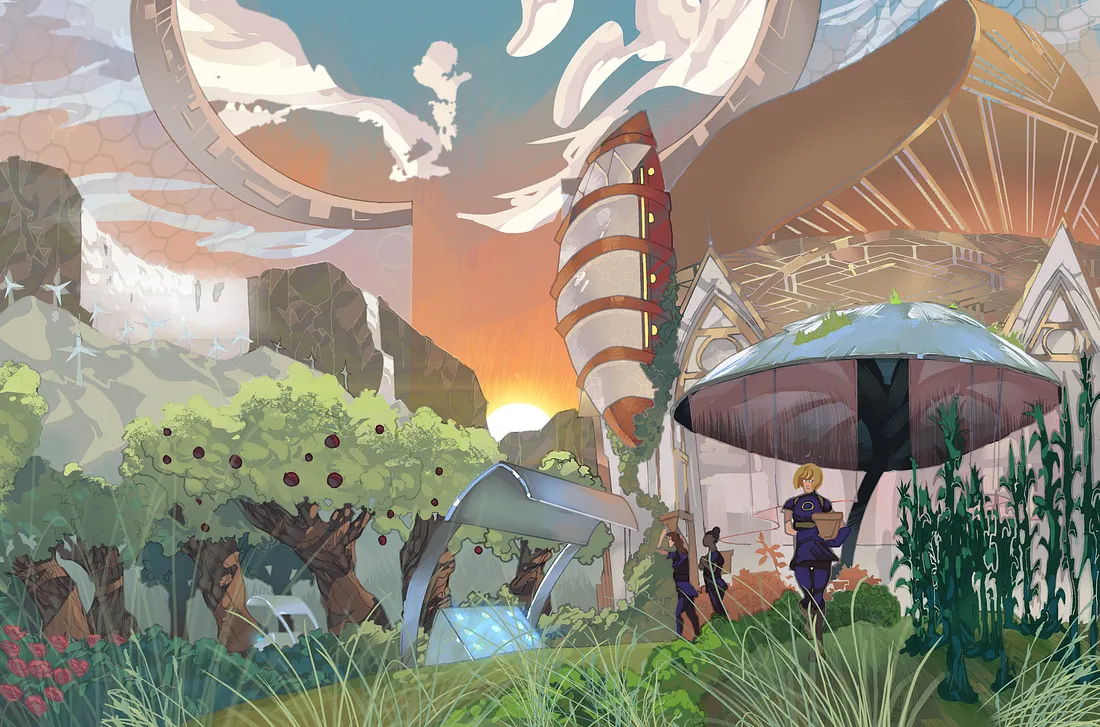Envision paradise in the face of catastrophe
Published:
You might think a horrible catastrophe is imminent due to climate change, plummeting birth rates, democratic backsliding or whatever your doom-of-choice is. In the face of such catastrophes it might seem unimportant, distracting or downright offensive to consider what beautiful futures might look like. However, I believe that thinking about the end goal is essential for steering towards positive outcomes.
The catastrophe I worry most about is the existential risk we face from the advent of Superintelligent AI that could plausibly happen in the next decade. As part of BlueDot’s AGI Strategy course I was reading about visions for better futures and found myself bouncing off of them. Shouldn’t we focus on avoiding doom instead of dreaming up some scenarios? Also aren’t all these scenarios unrealistic because of X? And think about all the things that could go wrong!
But upon reflection this attitude struck me as dull and uninspired. This prompted me to think about the value of imaging better futures and I now think every doomer should also think about the positive future they are fighting for. Note: The opposite advice also applies. If you only imagine nice futures without thinking about how things could go wrong you’d be well advised to identify potential blockers to your paradise.
In this essay I will lay out the reasons for thinking that imagining a beautiful vision is worth it. I’ll also describe some popular and my personal positive futures.
The utility of imagining beautiful futures
Uncover Hidden risks: When you’re laser-focused on preventing extinction, you might either miss other catastrophic risks or implement “solutions” that themselves lock in mediocrity. For example, we could stumble into catastrophe while avoiding extinction from misaligned AI, by hard coding our current, imperfect values into the model forever, thus locking current moral catastrophes by preventing moral progress. Alternatively, we could avoid catastrophe while locking in a suboptimal future by preventing any further development of AI and thus missing out on the huge upsides of the technology.
Reflect on our values: Thinking about good futures begs the question what is good according to your values. By imagining future scenarios it’s easy to identify values that are missing or that you value especially high. For me, reflecting on a future where all work is done by AI (sounds nice at first) led me to notice that I value being able to positively contribute to the world. For me, reflecting about a personal AI advisor made me notice that I strongly value humans being autonomous in shaping their own life.
Develop better strategies: By reframing the problem from “avoiding catastrophe” to “achieving paradise”, we can unlock new creative solutions and insights. This is akin to taking the dual in a math problem to make previously unsolvable problems easy. For example, after transforming “stop AI power concentration” into “build abundant access to AI”, I found it easier to think of solutions. Furthermore, you might gain new strategic considerations that a catastrophe-focused approach might miss. For example, it highlights that we should prioritise potential rather than preserving our current state by retaining human agency, diversity of thought and the ability to change instead of protecting specific jobs or institutions. It can also help to identify brief windows during the AI transition where we can shift entire trajectories.
A better source of motivation: Thinking about doom all day can be depressing. Pushing for an amazing future can be a more positive and healthy source of motivation. Personally, I also find it more fulfilling and meaningful. This could lead people to be more productive and avoid burnout and other mental health problems.
Popular visions of the future
I’ll note down some popular visions of utopia. While reading them, notice your reaction. Do you easily dismiss them? Which of these inspires you most? That reaction itself is data!
Transhumanism: Imagine uploading your consciousness, enhancing your intelligence a thousandfold, or living for centuries in bodies that never age. Transhumanists envision technology liberating us from the arbitrary limits of biology - where death becomes a choice rather than an inevitability.
A future without suffering: What if we could dial up happiness and dial down suffering through careful biological intervention, creating minds that experience gradients of bliss rather than pain? This vision seeks to eliminate involuntary suffering while preserving the complexity and meaning that make life worth living. (eg David Pearce’s Hedonistic Imperative).
Solarpunk: Picture cities where skyscrapers are vertical forests, where communities manage their own renewable energy grids, and where technology serves ecology rather than destroying it. Solarpunk rejects both dystopia and primitivism, insisting we can have both high-tech civilisation and a thriving natural world (A Vision for a Sustainable Future).

Post-scarcity: When AI, fusion, and space resources create infinite abundance, humans are freed from economic competition to pursue whatever fascinates them - art, science, exploration, connection. In this future, the question shifts from “can I afford this?” to “what do I truly want to create?” (eg Sam Altman’s Moore’s Law for Everything)
Network States/Charter Cities: Communities that share values coordinate online first, then establish physical territories with experimental governance - a thousand experiments in human organisation competing for citizens. Rather than being stuck with broken systems, people can exit to jurisdictions that actually work for them.
Fully Automated Luxury Communism: Robots do all the work while public ownership ensures everyone benefits, creating a leisure society where humans focus on art, love, and self-actualisation. The machines serve us all, not just those who own them.
Some inspiring Quotes and Resources
“Hope is not a lottery ticket you can sit on the sofa and clutch, feeling lucky. Hope is an axe you break down doors with in an emergency.” - Rebecca Solnit
“It’s easier to imagine the end of the world than the end of capitalism” - attributed to Fredric Jameson
“The future is not some place we are going, but one we are creating. The paths are not to be found, but made. And the activity of making them changes both the maker and the destination.” - John Schaar
“Optimism is a strategy for making a better future. Because unless you believe that the future can be better, you are unlikely to step up and take responsibility for making it so.” - Noam Chomsky
A list of related resources:
- Future of Life Inistitute’s World Building Contest
- Existential Hope
- Nick Bostrom’s Letter from Utopia and his book Deep Utopia: Life and Meaning in a Solved World
- Claude tells me there are some great positive sci-fi books, but I haven’t read them
- If you haven’t seen the movie Her you should
Go and reflect yourself
You should reflect for yourself how a good future looks like. I encourage you to reflect yourself (stealing from the BlueDot Course):
- Imagine a week in your life in 20 years, where you’re living a good, happy life. Consider going for a short walk to reflect on this.
- Over the next 20 years, we will welcome 2.7 billion new humans. How should the world look for them? Consider factors like politics, the economy, the social order and community, technological progress, and the environment.
After answering these questions in detail I dumped the notes into Claude and co-wrote a vision of day in 20 years. You can read the output here. I can highly recommend this exercise to write your own personalized, utopic sci-fi story.
